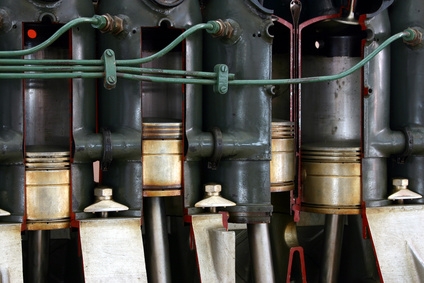
A crankshaft position sensor is standard equipment on almost all electronically fuel injected vehicles and gives the computer vital real-time information. Crankshaft position sensors are almost always found at the front or rear of the engine, either behind the crankshaft pulley or on its flywheel.
A crankshaft position sensor (CPS) is used in place of a distributor on computer-controlled engines. The CPS tells the computer where the crankshaft is in its rotational cycle. Crankshaft position directly relates to piston position, which determines the exact timing of individual cylinder fuel injection and spark plugs.
Most CPSs are magnetic Hall-Effect sensors similar to those used in the electronic distributors they replace. The crankshaft's gear-like tooth wheel (crank trigger wheel) passes within millimeters of a magnet (the CPS or Hall-Effect sensor) mounted in the timing case. As the high points on the trigger wheel pass the magnet, the current passing through the magnet changes in relation to the proximity of the gear's tooth. Think of the crank-trigger system as half of an electric motor. In an electric motor, a corresponding current goes through the gear wheel, causing movement. The CPS is passive and only detects the passage of the gear wheel.
Some engines use an optical CPS that works on a more easily understood principle. Optical CPS sensors use a laser that's mounted on one side of the sensor, which passes through the gaps in the gear wheel. The gear's teeth interrupt the laser beam, cutting voltage to the photovoltaic receptor "eye" on the other side. Optical sensors are a bit more reliable at high rotations per minute than magnetic sensors, which makes them best suited for racing applications.
Crank-trigger systems are far better at detecting crankshaft position than old-school distributors, which rely on voltage transmitted across a set of contacts to trigger the spark plugs. The primary problem with distributors is that their rotors spin at a high RPM, which minimizes the amount of time that current has to pass between their contacts, decreasing ignition voltage and timing accuracy. This inevitably leads to high RPM misfire, a problem that CPS systems almost never suffer from.
Being an electrical sensor, a CPS is sensitive to fluid contamination and short-circuiting. This can come in the form of internal fluid contamination (oil) or external fluid contamination (rainwater or puddles). External shorting is an endemic issue on engines that use a low-mounted CPS or one that sits in a water-trapping "well." Older Ford Explorers (which are often driven through puddles and mud) are known to suffer from just such external shorting. Additionally, magnetic sensors can be thrown off by metal shavings in the oil. Optical sensors can get blocked by dirt and debris, which is another reason they are primarily used in racing applications, where conditions are cleaner and where the sensors can be serviced regularly.